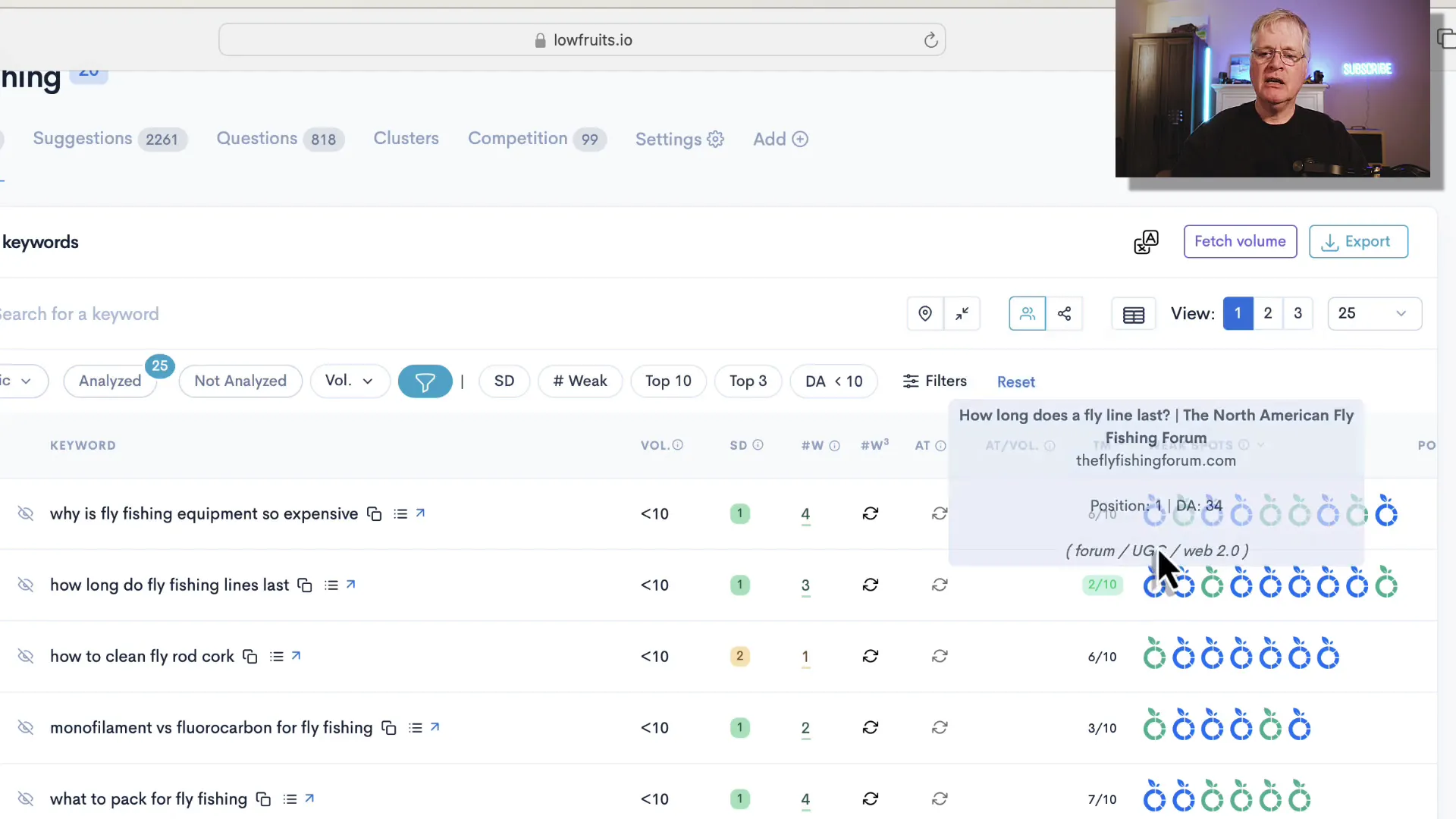LowFruits Review 2024: My Favorite Keyword Research Tool

In the changing landscape of SEO, finding the right keywords has become increasingly challenging. This blog explores how to leverage LowFruits for keyword research, especially in light of the changes brought about by Google's March 2024 Core Update. Discover effective strategies to identify rankable keywords and optimize your content for better visibility.
Introduction to the Lowfruits.io Keyword Research Tool
Keyword research is the backbone of any successful SEO strategy. It involves identifying the words and phrases that potential customers use when searching for products or services online. Understanding these keywords allows digital marketers to create content that meets the needs of their audience, ultimately driving traffic and improving rankings on search engines.
In the wake of Google's March 2024 Core Update, the landscape of keyword research has shifted. The SERPs (Search Engine Results Pages) are now influenced by a variety of factors, making it essential to adapt your approach. Tools like LowFruits play a crucial role in helping marketers discover low-competition keywords that can lead to higher rankings.
The Importance of Finding Low-Competition Keywords
Finding low-competition keywords is vital for achieving success in SEO. These keywords are often less targeted by competitors, allowing smaller websites to rank higher with quality content. By using a keyword research tool like LowFruits, you can uncover valuable insights into keyword opportunities that others may overlook.
In addition to identifying low-competition keywords, it’s important to focus on long-tail keywords. These are phrases that are typically longer and more specific, often resulting in lower competition and higher conversion rates. For instance, instead of targeting "fly fishing," you might target "best fly fishing gear for beginners."
The Impact of Google's March 2024 Core Update
Google's core updates are significant events that can drastically affect how websites are ranked in search results. The March 2024 Core Update has shifted the focus toward content quality and user engagement. As a result, many sites that previously ranked well may see a decline in their positions.
This update has particularly favored user-generated content, which has started to dominate the SERPs. Forums and social media platforms like Reddit are often ranking higher, making it harder for traditional websites to compete. Understanding these changes is crucial for adapting your keyword strategy.
Adapting Your Strategy Post-Update
To remain competitive, it’s essential to adapt your keyword research strategies. Here are a few tips:
- Focus on User Intent: Understand what users are looking for and tailor your content accordingly.
- Utilize Long-Tail Keywords: These keywords often have lower competition and can lead to higher conversion rates.
- Analyze SERPs: Regularly check the top results for your target keywords to understand what type of content is ranking.
LowFruits Keyword Research
LowFruits is a powerful keyword research tool designed to help marketers find valuable keyword opportunities. It stands out as one of the best tools on the market for generating keyword ideas and analyzing competition.
What makes LowFruits particularly useful is its ability to identify low-competition keywords quickly. By entering a seed keyword, users can access a long list of potential keywords that fit their niche. This is especially beneficial for those looking to improve their rankings in a competitive landscape.
Main LowFruits Features
LowFruits offers several features that make it an essential tool for digital marketers:
- Keyword Finder: Input your seed keyword to discover thousands of related keywords.
- Advanced Search Options: Filter results by including or excluding specific terms.
- Competition Analysis: View the domain authority of the top-ranking sites for each keyword.
Understanding LowFruits Dashboard
Upon logging into LowFruits, users are greeted with a user-friendly dashboard. This dashboard displays crucial information, such as available credits and previously run reports. Understanding how to navigate this dashboard is key to maximizing your keyword research efforts.
The dashboard also provides access to the keyword finder, where users can input their seed keywords and start generating ideas. The layout is designed to be intuitive, making it easy for anyone to use LowFruits effectively.
Credits and LowFruits Pricing
The LowFruits keyword tool primarily operates on a pay-as-you-go pricing model. This means users only pay for the credits they need, making it a cost-effective option for those who may not require consistent keyword research.
- $25: Get 2,000 credits.
- $60: Get 5,000 credits.
This pricing structure allows users to manage their expenses while still gaining access to a powerful keyword research tool. LowFruits is also available for a monthly subscription.

Find Low Competition Keywords with the LowFruits Keyword Finder
The LowFruits keyword finder is a straightforward tool that allows users to generate keywords based on a seed keyword. To get started, simply enter your seed keyword, select your target country and language, and hit search.
Once the search is complete, LowFruits will return a comprehensive list of keywords, complete with data on their competition and potential search volume. This feature is particularly useful for identifying long-tail keywords that can lead to higher rankings.

Advanced Search Features
LowFruits also includes advanced search features that allow users to refine their keyword searches. Users can include or exclude specific words, which is especially helpful when targeting niche topics.
Additionally, users can input their domain authority to filter results based on the competition level. This means that if you have a lower domain authority, you can focus on keywords that are more attainable for your site.

Utilizing Advanced Search Features
To maximize your keyword research, take advantage of the advanced search features. Here are some strategies to consider:
- Exclude Unwanted Terms: If you're not interested in certain topics, exclude those terms to streamline your results.
- Use Wildcards: Wildcard searches can help you discover variations of your seed keyword.
- Analyze SERPs: Regularly check the SERPs for your target keywords to identify trends and shifts in competition.

Analyzing Keyword Ideas and SERPs
When using LowFruits, analyzing keyword ideas and their corresponding SERPs is crucial. After inputting your seed keyword, the tool provides a comprehensive list of potential keywords, each with valuable data points, including competition levels and search volume.
For example, if you search for "fly fishing," LowFruits generates over 3,000 keyword ideas. However, it's essential to filter through these to avoid using too many credits at once. The goal is to focus on keywords that have potential for ranking, especially in a competitive landscape.

Understanding SERP Analysis
The SERP analysis feature allows users to see the competition for each keyword. You can identify the domain authorityof the top-ranking sites and assess whether you can compete effectively. Pay attention to the green fruits—these indicate websites with lower domain authority, which could represent viable opportunities for ranking.
Moreover, after the March 2024 update, many forums and user-generated content sites rank higher in the SERPs. This shift necessitates a strategic approach to keyword selection. By focusing on keywords with weaker competition, you can better position your content to rank successfully.

The Role of User-Generated Content in SERPs
User-generated content has gained prominence in SERPs, especially following the recent Google update. This change means that forums, social media platforms, and Q&A sites like Reddit are frequently at the top of search results.
For digital marketers, this trend highlights the importance of identifying keywords that can capitalize on this shift. By analyzing which user-generated pages rank for your target keywords, you can discover content gaps and opportunities for your own articles.

Strategies for Leveraging User-Generated Content
- Monitor User Engagement: Track discussions and questions in forums related to your niche. This can provide insight into what users are interested in.
- Identify Content Gaps: Look for topics that are underrepresented in user-generated content, which can be great opportunities for your articles.
- Engage with the Community: Participate in relevant forums to understand user needs better and tailor your content accordingly.

Identifying Low Competition Keywords
Identifying low-competition keywords is essential for improving your website's visibility. LowFruits excels at helping users uncover these keywords by providing detailed analysis of competition and search volume.
When you conduct a keyword search, LowFruits highlights keywords based on their competition levels. Focus on those that show a high potential for ranking but have lower competition scores. This strategy can significantly enhance your chances of ranking on the first page of SERPs.

Using Filters Effectively
LowFruits allows users to apply various filters when searching for keywords. These filters include:
- Domain Authority: Set a maximum domain authority to focus on keywords that are easier to rank for.
- Search Volume: Filter keywords based on their search volume to target terms that are likely to drive traffic.
- Include/Exclude Terms: Refine your search by specifying words that must or must not appear in the results.
Creating and Managing Keyword Lists
Effective keyword management is key to a successful SEO strategy. LowFruits enables users to create, manage, and export keyword lists effortlessly. This feature is particularly useful when planning content strategies or collaborating with teams.

To create a keyword list, simply select the keywords you're interested in and add them to a new or existing list. You can export these lists as CSV files for easy sharing or further analysis.

Organizing Your Keyword Strategy
Consider organizing your keywords into clusters based on topics or themes. This approach not only helps streamline your content creation process but also ensures that you cover related keywords comprehensively.
By maintaining a well-structured keyword list, you can easily track which keywords you're targeting and adjust your strategy as necessary. This method is especially beneficial as you analyze performance and make updates based on SEO trends.

Analyzing Competition and Weak Spots
Understanding your competition is crucial in the world of SEO. LowFruits provides detailed insights into the competition for each keyword, allowing you to identify potential weak spots in the market.
By analyzing which competitors are ranking for your target keywords, you can determine where you stand and what you need to do to improve your rankings. Look for opportunities where your content can outshine competitors with lower domain authority.

Strategies for Competing Effectively
- Content Quality: Focus on creating high-quality, valuable content that addresses user needs better than your competitors.
- Target Long-Tail Keywords: These often have less competition and can lead to more targeted traffic.
- Regularly Update Content: Keep your content fresh and relevant to maintain your rankings over time.

Utilizing Wildcard Searches for Broader Results
Wildcard searches are a powerful feature in LowFruits that can help uncover a broader range of keyword ideas. By using an asterisk (*) in your search, you can generate variations of your seed keyword.
For instance, searching for "best * for fly fishing" can yield numerous results, helping you discover unique content opportunities that may not have been immediately obvious.

Benefits of Wildcard Searches
- Diversified Keyword Ideas: Expand your keyword list with variations that cater to different user intents.
- Uncover Hidden Opportunities: Find niche keywords that may have less competition but are still relevant to your audience.
- Enhanced Content Strategy: Use the results to inform your content creation and marketing strategies effectively.
Final Thoughts on my LowFruits.io Review for Keyword Research
LowFruits is a game-changer for digital marketers looking to enhance their keyword research efforts and find low competition . Its user-friendly interface, combined with powerful features, makes it one of the best keyword research tools available.
By leveraging the insights provided by LowFruits, you can identify low competition keywords, analyze SERPs, and better understand your competition. This comprehensive approach will help improve your content strategy and ultimately boost your rankings.

For more insights on maximizing your online presence, check out our blog on blog maintenance. It's essential for keeping your site fresh and engaging!
Frequently Asked Questions
Q: What is LowFruits.io and how does it help with keyword research?
A: LowFruits.io is a keyword research tool that helps you find keywords with low competition, making it easier to rank in search engines. It’s designed to give you a long list of keywords based on your initial seed keyword, focusing on low domain authority phrases.
Q: Can you give me a quick lowfruits review?
A: Sure! LowFruits is super user-friendly and great for anyone wanting to dive into keyword research. It helps you find keywords that have weak spots in your niche, making it easier to target SEO keywords that can boost your rankings.
Q: What are the main features of LowFruits?
A: Some of the main features include the ability to analyze SERPs, find keywords with low difficulty, and access a keyword report that gives you a comprehensive look at keyword clusters. It’s really the ultimate keyword research tool for anyone serious about SEO!
Q: Are there any good lowfruits alternatives out there?
A: Absolutely! While LowFruits is fantastic, there are other tools like Ahrefs and SEMrush that also offer keyword research capabilities. However, if you’re looking specifically for low competition keywords, LowFruits might be your best bet!
Q: How does LowFruits handle keyword difficulty?
A: LowFruits uses Google to analyze keyword difficulty and helps you find keywords that are easier to rank for. This way, you can focus on keywords that have lower competition, increasing your chances of ranking higher in search results.
Q: What’s the subscription model for LowFruits like?
A: LowFruits offers a subscription model where you pay per keyword. It’s pretty flexible, allowing you to buy credits based on your needs. This is great if you’re just getting started and don’t want to commit to a full-blown package right away.
Q: Can I use this tool to find keywords for free?
A: Yes! LowFruits offers some options to find keywords for free, though the full suite of features is available through a paid subscription. It’s a good way to test the waters before diving deeper.
Q: How does LowFruits help you find keyword suggestions?
A: LowFruits helps by generating a long list of keyword ideas based on your input. You can enter 1 keyword, and it will provide suggestions that fit within your niche, including longtail keywords that might be easier to rank for.
Q: Is LowFruits suitable for beginners in SEO?
A: Definitely! Anyone can use LowFruits, even if you're just starting out. Its intuitive design and straightforward features make it easy to navigate and useful for all levels of SEO expertise.



